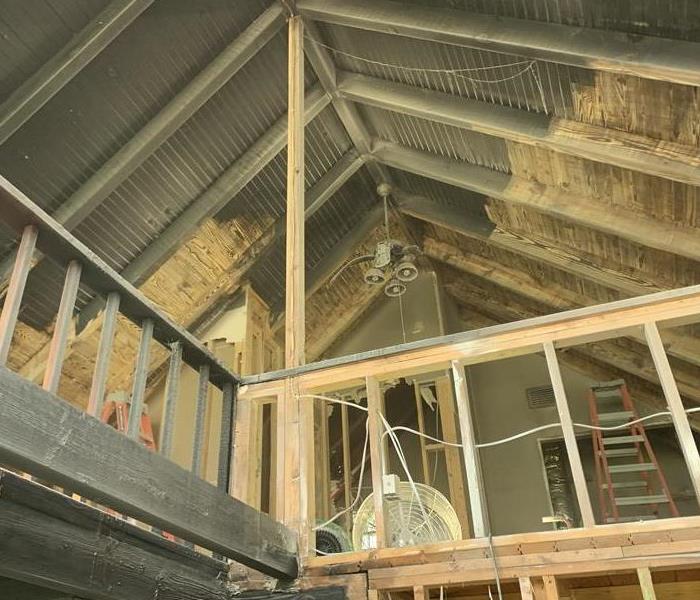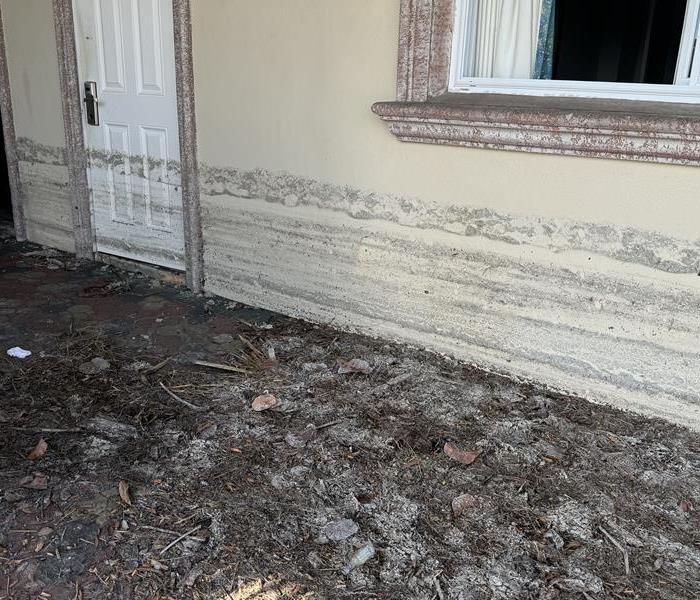Recent Posts
How to Prevent Garage Fires: Essential Tips for Safety
12/11/2024 (Permalink)
Garage fires pose a significant risk to homeowners. Often filled with flammable materials like gasoline, motor oil, and paint, garages can be particularly susceptible to fires. Whether it's due to improper storage or malfunctioning equipment, garage fires can spread quickly to the rest of your home. Fortunately, there are steps you can take to minimize the risk. By following key preventive measures, you can protect your property and loved ones from fire hazards. In the event of a fire, SERVPRO® is available to assist with professional fire restoration services.
1. Proper Storage of Flammable Materials
One of the main causes of garage fires is improper storage of flammable substances. Gasoline, propane, motor oil, and paint are common in many garages, but storing them correctly is crucial. These items should be kept in airtight, clearly labeled containers, stored on high shelves away from heat sources and electrical outlets.
Additionally, avoid storing large quantities of flammable materials. Keep only what you need, and properly dispose of anything you no longer use. If you have larger items like propane tanks, store them outside the garage in well-ventilated areas to reduce fire risk.
2. Maintain Electrical Systems
Faulty wiring or electrical malfunctions can easily spark a fire in your garage. Check for frayed wires, outdated electrical systems, or overloaded outlets. If you use tools and appliances in your garage, such as space heaters or power tools, ensure that they are in good working order and have up-to-date safety features.
Extension cords are also common culprits for garage fires. While they can be convenient, they are not meant for long-term use with high-powered appliances. Consider installing additional outlets rather than relying on extension cords to minimize fire risks.
3. Regularly Clean and Declutter
Garages often become catch-all spaces for unused items and clutter. However, a cluttered garage can fuel a fire, making it easier for flames to spread quickly. Regularly clean and organize your garage, removing items that can easily ignite, like paper, cardboard, or fabric. Keep walkways clear and avoid storing large amounts of combustible materials near potential fire sources.
4. Install Fire Safety Equipment
Equipping your garage with fire safety devices can prevent a small spark from becoming a large fire. Install a smoke detector in or near the garage and test it regularly. Consider adding a fire extinguisher in the garage and ensure everyone in the household knows how to use it. In case of a fire, these tools can help contain the flames before they spread to the rest of your home.
5. Be Cautious with Appliances and Machinery
Garages are often used as workshops where power tools, lawnmowers, and other equipment are stored. Always allow tools that run on gasoline, like lawnmowers or chainsaws, to cool down before storing them inside the garage. Make sure these items are in good working order, free of fuel leaks, and stored properly.
SERVPRO for Fire Restoration
Despite your best efforts, accidents can still happen. In the unfortunate event of a garage fire, SERVPRO of Montgomery County is here to help with comprehensive fire restoration services. From cleaning up soot and smoke damage to restoring your property, SERVPRO has the expertise to make your home safe and comfortable again. By acting quickly, our team can prevent further damage and ensure that your garage and home are restored to pre-fire condition.
Protect your garage and home by taking the necessary precautions, and trust SERVPRO of Montgomery County to be your partner in fire restoration when needed.
??Mold in Vacation Rentals: Ensuring Guest Safety and Property Protection
11/13/2024 (Permalink)
Vacation rentals are designed to offer guests a comfortable, home-away-from-home experience. However, the presence of mold can quickly turn that experience into a nightmare for both guests and property owners. Mold thrives in damp, poorly ventilated environments, and if not properly addressed, it can cause damage to the property and lead to guest dissatisfaction. Ensuring your vacation rental is mold-free not only protects your investment but also guarantees a safe and pleasant environment for your guests.
In this blog, we’ll explore how to prevent mold in vacation rentals, the impact of mold on guest experiences, and why professional mold remediation services like SERVPRO of Montgomery County are essential for maintaining your property.
Why Mold is a Problem in Vacation Rentals
Vacation rentals are often located in regions with high humidity or near water, which creates the ideal conditions for mold growth. Properties that sit unoccupied for long periods, particularly in areas prone to rain, humidity, or leaks, are especially vulnerable to mold issues. Mold can develop in unseen areas like under carpets, behind walls, or in basements, where moisture can accumulate.
For property owners, mold can lead to significant structural damage, reduce the value of the rental, and necessitate expensive repairs. For guests, encountering mold can severely impact their stay, leading to negative reviews and a tarnished reputation for your rental business.
Key Areas Where Mold is Likely to Develop in Vacation Rentals
Mold can grow in almost any area of a property where moisture is present. The most common areas for mold growth in vacation rentals include:
- Bathrooms: High humidity, poor ventilation, and constant water exposure make bathrooms prime spots for mold.
- Kitchens: Leaks under sinks, around appliances, or in cabinets can foster hidden mold growth.
- Basements and crawl spaces: Often damp and poorly ventilated, these areas are particularly susceptible to mold.
- Air conditioning units: In warmer climates, mold can build up inside HVAC systems, circulating spores throughout the property.
- Laundry rooms: Frequent use of washing machines can create a humid environment perfect for mold growth.
Preventative Measures to Keep Mold Out of Your Vacation Rental
As a vacation rental owner, there are several steps you can take to minimize the risk of mold development and keep your property safe for guests.
1. Control Moisture Levels
Controlling moisture is the most effective way to prevent mold. Use dehumidifiers in humid environments and ensure proper ventilation in bathrooms and kitchens. Installing exhaust fans in areas prone to moisture and humidity, such as bathrooms, laundry rooms, and kitchens, can help reduce the buildup of damp air.
2. Regular Inspections
Inspect your property regularly, especially during the off-season when it may be unoccupied for long periods. Check for leaks in plumbing, around windows and doors, and in the roof. Make sure gutters and downspouts are properly functioning and directing water away from the foundation. Catching and fixing leaks early can prevent moisture buildup and stop mold before it starts.
3. Maintain the HVAC System
An improperly maintained HVAC system can harbor mold, which can then spread throughout the property. Regularly inspect and clean air conditioning units, ducts, and filters to ensure that moisture is not building up inside the system. SERVPRO offers professional HVAC cleaning and mold remediation services to help keep your vacation rental’s air quality in check.
4. Use Mold-Resistant Materials
In areas where moisture is a regular issue, consider using mold-resistant materials. Mold-resistant drywall, paint with mold inhibitors, and waterproof flooring are great options for bathrooms, kitchens, and basements. This extra layer of protection can go a long way in preventing mold growth in high-risk areas.
5. Monitor Humidity Levels
Using humidity monitors in key areas of the home can help alert you when humidity levels are too high, which can promote mold growth. Ideally, indoor humidity levels should stay below 60%. Dehumidifiers can be used to help control moisture levels, especially in basements or during humid weather conditions.
How SERVPRO Can Help with Mold Remediation in Vacation Rentals
SERVPRO® specializes in mold remediation, offering a comprehensive approach to mold removal. Our team follows strict protocols to ensure that mold is effectively contained and eliminated from your property. Here's how we approach mold remediation in vacation rentals:
- Mold Assessment: We identify areas affected by mold and the source of moisture contributing to its growth.
- Containment: We use advanced techniques to prevent mold spores from spreading to unaffected areas.
- Air Filtration: Our HEPA filtration systems capture mold spores from the air to improve indoor air quality.
- Mold Removal: SERVPRO's technicians remove mold-infested materials and clean surfaces with antimicrobial treatments.
- Moisture Control: We identify and resolve the moisture problem to prevent future mold growth.
SERVPRO provides expert mold remediation services to vacation rental owners, ensuring your property remains safe, clean, and welcoming for guests. Don’t let mold affect your rental business—take proactive steps today to keep your property mold-free and ensure a positive guest experience.
Rebuilding After Water Damage: Choosing Sustainable Materials
10/16/2024 (Permalink)
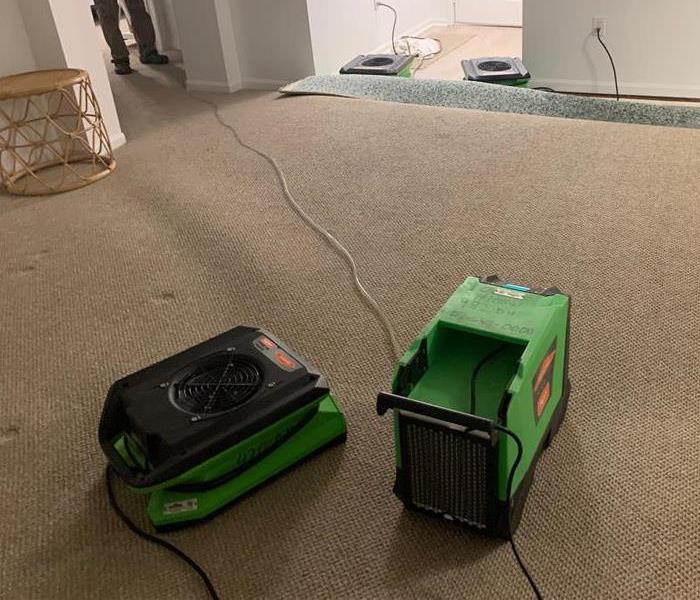 Rebuilding after water damage is an opportunity to create a more sustainable and resilient space.
Rebuilding after water damage is an opportunity to create a more sustainable and resilient space.
When water damage occurs in your home or business, the aftermath can be overwhelming. Beyond the immediate concern of water extraction and drying, you also face the challenge of rebuilding. In this critical phase, choosing sustainable materials can make a significant difference in both the durability of your property and its environmental impact. At SERVPRO®, we understand the importance of making informed decisions during the restoration process. Here’s a guide to selecting sustainable materials for your rebuilding efforts after water damage.
The Importance of Sustainability in Rebuilding
Sustainability isn’t just a buzzword; it’s a practical approach to building that focuses on reducing environmental impact while ensuring the longevity and resilience of your property. After experiencing water damage, incorporating sustainable materials into your rebuild can help create a healthier, more energy-efficient space. These materials are designed to withstand the test of time and resist further damage, reducing the need for frequent repairs and replacements.
Sustainable Flooring Options
Flooring is often one of the most affected areas during water damage, and replacing it offers an excellent opportunity to go green. Bamboo and cork are two sustainable options that are gaining popularity. Bamboo is a rapidly renewable resource that offers the durability of hardwood while being more water-resistant. Cork, harvested from the bark of cork oak trees, is not only sustainable but also naturally resistant to mold and mildew, making it an excellent choice for areas prone to moisture.
For those looking for more traditional options, recycled or reclaimed wood is a great choice. It provides the timeless look of wood flooring while reducing the demand for new timber. Additionally, opting for tiles made from recycled glass or ceramic can add an eco-friendly touch to your floors, offering both durability and aesthetic appeal.
Eco-Friendly Wall Materials
Water-damaged walls often need to be replaced, and this is another area where sustainable materials can shine. Recycled drywall, made from gypsum waste, is an environmentally friendly alternative to traditional drywall. It offers the same performance while reducing landfill waste. Another option is to use low-VOC (volatile organic compound) paints, which minimize harmful emissions during application and contribute to better indoor air quality.
For a more natural look, consider using reclaimed wood or sustainable wood alternatives like bamboo for wall paneling. These materials are not only eco-friendly but also add warmth and character to your interiors.
Insulation and Energy Efficiency
Rebuilding after water damage provides the perfect opportunity to upgrade your insulation with sustainable options. Materials like cellulose insulation, made from recycled newspaper, offer excellent thermal performance and are more environmentally friendly than traditional fiberglass insulation. Sheep’s wool and recycled cotton are other sustainable insulation choices that provide effective thermal regulation and soundproofing.
Rebuilding after water damage is an opportunity to create a more sustainable and resilient space. By choosing eco-friendly materials for your floors, walls, and insulation, you can reduce your environmental impact while enhancing the durability of your property. At SERVPRO, we’re here to guide you through every step of the restoration process, ensuring that your rebuild not only restores but also improves your living or working environment.
Rebuilding After Water Damage: Choosing Sustainable Materials
10/16/2024 (Permalink)
 At SERVPRO, we’re here to guide you through every step of the restoration process.
At SERVPRO, we’re here to guide you through every step of the restoration process.
When water damage occurs in your home or business, the aftermath can be overwhelming. Beyond the immediate concern of water extraction and drying, you also face the challenge of rebuilding. In this critical phase, choosing sustainable materials can make a significant difference in both the durability of your property and its environmental impact. At SERVPRO®, we understand the importance of making informed decisions during the restoration process. Here’s a guide to selecting sustainable materials for your rebuilding efforts after water damage.
The Importance of Sustainability in Rebuilding
Sustainability isn’t just a buzzword; it’s a practical approach to building that focuses on reducing environmental impact while ensuring the longevity and resilience of your property. After experiencing water damage, incorporating sustainable materials into your rebuild can help create a healthier, more energy-efficient space. These materials are designed to withstand the test of time and resist further damage, reducing the need for frequent repairs and replacements.
Sustainable Flooring Options
Flooring is often one of the most affected areas during water damage, and replacing it offers an excellent opportunity to go green. Bamboo and cork are two sustainable options that are gaining popularity. Bamboo is a rapidly renewable resource that offers the durability of hardwood while being more water-resistant. Cork, harvested from the bark of cork oak trees, is not only sustainable but also naturally resistant to mold and mildew, making it an excellent choice for areas prone to moisture.
For those looking for more traditional options, recycled or reclaimed wood is a great choice. It provides the timeless look of wood flooring while reducing the demand for new timber. Additionally, opting for tiles made from recycled glass or ceramic can add an eco-friendly touch to your floors, offering both durability and aesthetic appeal.
Eco-Friendly Wall Materials
Water-damaged walls often need to be replaced, and this is another area where sustainable materials can shine. Recycled drywall, made from gypsum waste, is an environmentally friendly alternative to traditional drywall. It offers the same performance while reducing landfill waste. Another option is to use low-VOC (volatile organic compound) paints, which minimize harmful emissions during application and contribute to better indoor air quality.
For a more natural look, consider using reclaimed wood or sustainable wood alternatives like bamboo for wall paneling. These materials are not only eco-friendly but also add warmth and character to your interiors.
Insulation and Energy Efficiency
Rebuilding after water damage provides the perfect opportunity to upgrade your insulation with sustainable options. Materials like cellulose insulation, made from recycled newspaper, offer excellent thermal performance and are more environmentally friendly than traditional fiberglass insulation. Sheep’s wool and recycled cotton are other sustainable insulation choices that provide effective thermal regulation and soundproofing.
Rebuilding after water damage is an opportunity to create a more sustainable and resilient space. By choosing eco-friendly materials for your floors, walls, and insulation, you can reduce your environmental impact while enhancing the durability of your property. At SERVPRO, we’re here to guide you through every step of the restoration process, ensuring that your rebuild not only restores but also improves your living or working environment.
Essential Dos and Don'ts for Safely Using Generators During Storm Outages
9/10/2024 (Permalink)
When storms hit and power outages occur, generators can be a lifesaver, providing essential electricity to keep your home running. However, improper use of generators can pose serious risks, including carbon monoxide poisoning, fire hazards, and electrical shocks. This blog will outline the dos and don'ts of using generators during storm outages to ensure your safety and the safety of your household.
Do Choose the Right Generator
- Assess Your Needs: Determine the power requirements of the essential appliances and devices you need to run during an outage.
- Select an Appropriate Model: Choose a generator that meets or exceeds your power needs. Consider a portable or standby generator based on your requirements and budget.
Do Read the Manual
- Understand Operation: Thoroughly read the manufacturer’s instructions and guidelines for safe operation.
- Follow Maintenance Tips: Adhere to the recommended maintenance schedule to ensure your generator operates efficiently and safely.
Do Install Carbon Monoxide Alarms
- CO Detectors: Install carbon monoxide detectors in your home, especially near sleeping areas, to alert you of any dangerous CO buildup.
- Regular Checks: Test detectors regularly to ensure they are functioning properly.
Do Use Outdoor Only
- Proper Ventilation: Always operate generators outdoors in well-ventilated areas, away from windows, doors, and vents.
- Safe Distance: Keep the generator at least 20 feet away from your home to prevent carbon monoxide from entering your living space.
Do Ground the Generator
- Prevent Electrical Hazards: Ground your generator according to the manufacturer’s instructions to reduce the risk of electrical shocks and surges.
- Use Appropriate Cords: Utilize heavy-duty, outdoor-rated extension cords with a sufficient gauge to handle the electrical load.
Do Keep Fuel Safe
- Proper Storage: Store fuel in approved containers, away from living areas, and in a cool, well-ventilated place.
- Refuel Safely: Turn off the generator and let it cool down before refueling to prevent fire hazards.
Do Perform Regular Maintenance
- Routine Checks: Regularly inspect and maintain your generator to ensure it remains in good working condition.
- Professional Servicing: Have your generator serviced by a professional annually or as recommended by the manufacturer.
Don’t Operate Indoors
- Avoid Enclosed Spaces: Never run a generator inside your home, garage, basement, or any enclosed or partially enclosed space.
- Prevent CO Poisoning: Operating indoors can lead to dangerous carbon monoxide buildup, which can be fatal.
Don’t Connect Directly to Home Wiring
- Avoid Backfeeding: Do not plug the generator directly into a wall outlet or connect it to your home’s electrical panel without a professionally installed transfer switch.
- Use Transfer Switch: A transfer switch isolates your home’s wiring from the utility grid, preventing back feeding and protecting utility workers from electrocution.
Don’t Overload the Generator
- Know the Limits: Be aware of your generator’s wattage capacity and avoid exceeding it by running too many appliances simultaneously.
- Prioritize Essentials: Use the generator to power only essential appliances and devices to prevent overload and potential damage.
Don’t Use in Wet Conditions
- Avoid Water Exposure: Do not operate the generator in wet or rainy conditions, as water can cause electrical shorts and shocks.
- Use Canopy: If necessary, use a generator canopy or tent designed to protect it from the elements while ensuring proper ventilation.
Don’t Forget Emergency Preparedness
Keep an adequate supply of fuel, oil, and necessary spare parts on hand for extended outages. Have an emergency kit ready with flashlights, batteries, first-aid supplies, and non-perishable food items.
Generators can provide vital power during storm outages, but their safe operation is paramount. By following these dos and don’ts, you can ensure the safety of your household and prevent potential hazards associated with generator use. Always prioritize safety, adhere to manufacturer guidelines, and be prepared to handle power outages effectively. Stay safe and powered up with the proper use of your generator.
The Dangers of Smoking in the Home: Understanding the Risks and SERVPRO's Role in Mitigation
8/7/2024 (Permalink)
The consequences of smoking indoors can lead to severe fire hazards, indoor air quality issues, and extensive property damage. This blog will explore the dangers associated with smoking in the home and how SERVPRO® can help mitigate these risks through professional cleaning and restoration services.
The Risks of Smoking Indoors
Cigarette fires are a leading cause of residential fires, causing injuries, fatalities, and significant property damage. Cigarettes that are not extinguished properly can smolder in furniture, bedding, or trash, posing a constant fire risk. Cigarette smoke leaves a strong, persistent odor that can penetrate walls, furniture, carpets, and other household items. This odor is difficult to remove and can affect the comfort and livability of a home. Tar and nicotine from cigarettes can stain walls, ceilings, and fabrics, leading to cosmetic damage and the need for extensive cleaning and restoration efforts.
SERVPRO’s Role in Mitigating Smoking-Related Damage
Air Quality Improvement: SERVPRO utilizes advanced cleaning techniques and air purification systems to remove smoke residues and odors from the air. This helps to improve indoor air quality, making the home safer and more comfortable for residents.
SERVPRO’s trained professionals use specialized cleaning agents and equipment to clean walls, ceilings, and surfaces affected by smoke and tar residues. This thorough cleaning process helps to remove stains and odors, restoring the home’s appearance.
Odor Removal: Persistent smoke odors require professional treatment to fully eradicate. SERVPRO offers odor removal services that can neutralize and remove smoke odors from all affected areas, using techniques such as ozone treatments, air scrubbing, and thermal fogging.
In cases where the damage is extensive, SERVPRO provides restoration services to repair and replace damaged materials. This may include repainting walls, replacing carpets, and refurbishing furniture to return the home to its pre-smoking condition. SERVPRO’s experts also provide advice on how to prevent smoking-related damage in the future, including suggestions for better ventilation and regular cleaning practices.
Smoking in the home can lead to numerous risks, including fire hazards and significant property damage. Understanding these dangers and taking proactive measures can help mitigate the risks associated with indoor smoking.
SERVPRO is committed to helping homeowners address and recover from the damage caused by smoking through comprehensive cleaning and restoration services. If your home has been affected by smoking, contact SERVPRO of Montgomery County for professional help to restore your environment to a safe and comfortable living space.
The Importance of Mold Testing in Real Estate Deals: What Buyers and Sellers Need to Know
7/10/2024 (Permalink)
 Mold testing is a critical component of real estate transactions that protects both buyers and sellers.
Mold testing is a critical component of real estate transactions that protects both buyers and sellers.
When you're buying or selling a home, you want to ensure that everything is in top shape for the transaction to proceed smoothly. One critical aspect that shouldn't be overlooked is the presence of mold. Mold testing can play a significant role in real estate transactions, providing peace of mind for both buyers and sellers. Here’s how mold testing impacts real estate deals and why it’s important.
Why Mold Testing Matters in Real Estate
Mold can be a deal-breaker in real estate transactions. Not only can it cause damage to the property, but it can also lead to delays in the closing process. For buyers, discovering mold after purchasing a home can be expensive and frustrating. For sellers, undisclosed mold issues can result in legal liabilities and lost deals. That's why mold testing is a crucial step in the real estate process.
For Sellers: Preparing Your Home for Sale
If you're selling your home, conducting a mold inspection before listing it can provide several advantages:
- Transparency: Providing proof of a mold-free home or documentation of resolved mold issues can boost buyer confidence.
- Value Preservation: Addressing mold problems before listing the property can help maintain the home's market value.
- Smooth Transactions: Resolving issues beforehand can lead to quicker, smoother real estate transactions without last-minute negotiations or buyer demands.
For Buyers: Ensuring a Safe Investment
For home buyers, mold testing is an essential due diligence step:
- Ensuring the home is free from mold enhances the living environment.
- Identifying mold issues before finalizing the purchase can save on future remediation costs.
- If mold is found, buyers can negotiate repair credits, a lower price, or request that the seller address the mold issues before closing.
How Mold Testing Works
Mold testing involves a detailed inspection of the property by certified professionals who will:
- Identify Signs of Mold Growth: Inspectors look for visible signs of mold growth and areas susceptible to mold, such as basements, bathrooms, around windows, and in HVAC systems.
- Measure Moisture Levels: Since mold thrives in moist environments, inspectors use tools to measure humidity and moisture in walls, floors, and ceilings.
- Collect Samples: If necessary, they will collect air and surface samples to test for mold spores, which are sent to a lab to identify the type and concentration of mold present.
When to Schedule Mold Testing
Mold testing is recommended:
- Before Listing or Buying a Home
- After Identifying Potential Issues
- Following Major Repairs
Mold testing is a critical component of real estate transactions that protects both buyers and sellers. It ensures that properties are safe, habitable, and free from mold-related problems that could affect property values. For those involved in real estate transactions, including a mold inspection in the buying or selling process can lead to a smoother, more secure deal.
If you're considering buying or selling a property and need professional mold testing, don't hesitate to reach out to the experts. At SERVPRO of Montgomery County, we have the tools and expertise to conduct thorough mold inspections and remediation if needed. Our goal is to help you make informed decisions and ensure that your real estate transactions are safe and sound.
Water-Damaged Upholstery: Cleaning for Safety and Longevity
6/12/2024 (Permalink)
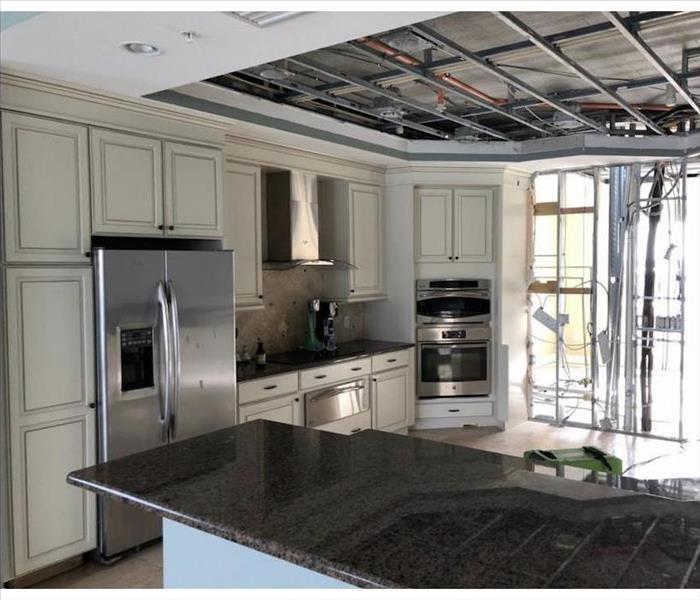 In this blog, we discuss effective strategies for cleaning upholstery after water damage and restoring your fabric items to their preloss condition.
In this blog, we discuss effective strategies for cleaning upholstery after water damage and restoring your fabric items to their preloss condition.
Water damage in your home can be a disruptive and stressful experience, especially when it affects your upholstered furniture and fabric items. Knowing how to properly clean and restore water-damaged upholstery is crucial for ensuring safety and preserving the longevity of your belongings. In this blog, we will discuss effective strategies for cleaning upholstery after water damage and restoring your fabric items to their preloss condition.
Assessing the Damage
The first step in cleaning water-damaged upholstery is to assess the extent of the damage. Look for signs of water saturation, staining, discoloration, and any potential mold or mildew growth on the fabric. Understanding the scope of the damage will guide your cleaning and restoration efforts.
Dry the Upholstery
After assessing the damage, it's important to begin the drying process as soon as possible. Use fans, dehumidifiers, and open windows to promote air circulation and assist in drying out the upholstery. Avoid using high heat or direct sunlight, as this may cause further damage to the fabric.
Clean and Sanitize
Once the upholstery is adequately dried, it's time to clean and sanitize the fabric. Use a gentle upholstery cleaner or a mixture of mild detergent and water to spot-clean the affected areas. Test the cleaning solution on a small, inconspicuous area first to ensure it does not cause damage or discoloration.
Blot, Do Not Rub
When cleaning water-damaged upholstery, it's crucial to blot the fabric with a clean, dry cloth or sponge to absorb excess moisture and cleaning solution. Avoid rubbing the fabric, as this can spread the stain and cause damage to the fibers.
Professional Fabric Restoration
In cases of severe water damage or extensive staining, consider seeking professional assistance for fabric restoration and upholstery cleaning. Professional restoration technicians have the expertise, tools, and techniques to effectively clean and restore water-damaged upholstery, ensuring the best possible outcome for your fabric items.
Prevent Mold and Mildew
Water damage can create ideal conditions for mold and mildew growth on upholstery. To prevent this, ensure that the fabric is thoroughly dried and properly ventilated. Consider using a dehumidifier to control humidity levels and inhibit mold and mildew formation.
Consult Professional Contents Restoration Services
If your upholstered furniture and fabric items have sustained significant water damage, consider consulting professional content restoration services. These specialists can assess the damage, provide expert cleaning and restoration, and help salvage your valuable possessions.
Regular Maintenance and Care
To maintain the longevity and cleanliness of your upholstery, implement regular maintenance and care practices. Vacuum your upholstered furniture regularly, use fabric protectors to guard against future spills, and promptly address any water damage or stains to prevent long-term damage.
In conclusion, cleaning water-damaged upholstery is essential for ensuring the safety and longevity of your fabric items. By promptly assessing the damage, thoroughly drying the fabric, using gentle cleaning methods, and seeking professional assistance when needed, you can effectively clean and restore water-damaged upholstery. Remember, for comprehensive fabric restoration and upholstery cleaning services, consider reaching out to SERVPRO® for professional guidance and support. Our trained professionals can help you navigate the restoration process and preserve the beauty and integrity of your upholstered furniture and fabric items.
The Impact of Water Damage after a House Fire
4/17/2024 (Permalink)
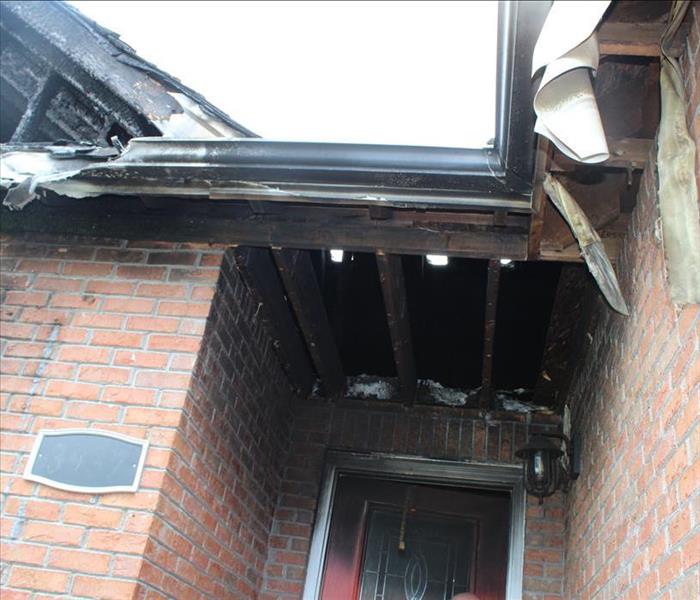 In this blog, we will explore the impact of water damage after a house fire and what the restoration process entails.
In this blog, we will explore the impact of water damage after a house fire and what the restoration process entails.
Experiencing a house fire can be devastating, but the damage doesn't stop with the flames. The firefighting efforts often involve significant amounts of water, leading to water damage in addition to fire damage. Understanding how water damage can occur after a house fire and the restoration process is crucial for successful fire remediation. In this blog, we will explore the impact of water damage after a house fire and what the restoration process entails.
Firefighting Efforts and Water Damage
When firefighters arrive at the scene of a house fire, they use water to extinguish the flames. This water can infiltrate various parts of your property, causing widespread water damage. Areas such as walls, ceilings, floors, and belongings can become saturated with water, leading to structural instability, mold growth, and further damage. It is essential to address the water damage along with the fire damage to prevent future complications.
Water Extraction and Drying
The restoration process begins with water extraction to remove excess water from the affected areas. Water restoration professionals use specialized equipment like pumps, wet/dry vacuums, and dehumidifiers to extract water and moisture effectively. This step is crucial to prevent further damage, and mold growth, and to restore the property to its pre-fire condition.
Structural Restoration and Repair
Water damage after a fire can compromise the structural integrity of your property. The restoration process involves assessing and repairing any structural components affected by water, such as walls, ceilings, and floors. Professional fire remediation companies like SERVPRO® have the expertise to identify structural issues and work closely with contractors to ensure proper reconstruction and restoration.
Mold Prevention and Remediation
Excessive moisture resulting from firefighting efforts can create optimal conditions for mold growth. Mold can start to form within 24-48 hours after water damage occurs. As part of the restoration process, professionals conduct thorough inspections to detect any signs of mold growth. If present, they will initiate mold remediation procedures to eliminate the mold and prevent future growth.
Content Assessment and Restoration
Water damage can also affect personal belongings, furniture, and other items within the property. Fire remediation specialists assess the damage to determine salvageable items and provide necessary restoration services. This may involve specialized cleaning, drying, and deodorization techniques, ensuring your belongings are properly restored.
Odor Elimination
Water damage, combined with fire damage, can leave behind persistent odors on your property. These odors can be unpleasant and difficult to remove without professional help. Fire remediation professionals employ various techniques such as thermal fogging, ozone treatments, or air scrubbers to neutralize and eliminate odors, leaving your property fresh and odor-free.
Water damage can be an unfortunate consequence of firefighting efforts during a house fire. Addressing both fire damage and water damage is crucial for a complete restoration process. Professional fire remediation companies like SERVPRO® have the expertise, equipment, and experience to handle all aspects of fire damage cleanup, water extraction, and restoration. If you experience a house fire, contact professionals who can promptly respond, assess the damage, and provide efficient fire damage and water damage restoration services to mitigate further damage and bring your property back to its pre-fire condition.
The Importance of Clearing Gutters and Drains Before the Storm Hits
4/6/2024 (Permalink)
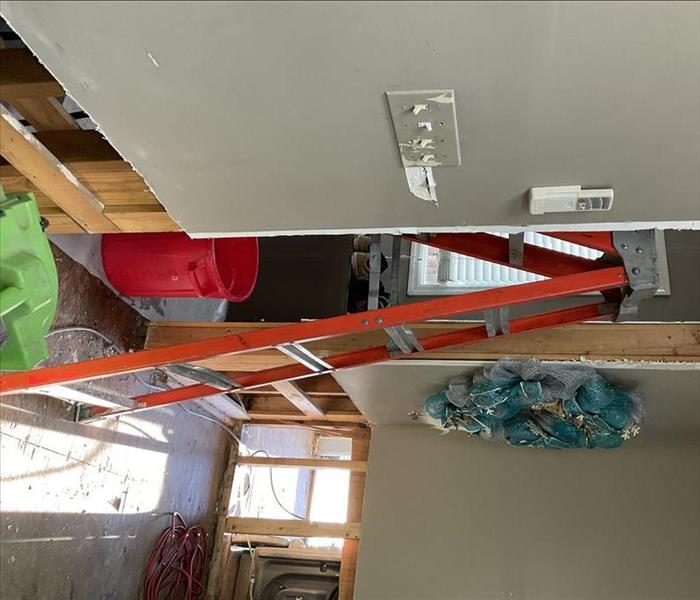 In this blog post, we will explore the importance of clearing gutters and drains before storm damage and provide some helpful tips to follow.
In this blog post, we will explore the importance of clearing gutters and drains before storm damage and provide some helpful tips to follow.
When a storm emergency hits, it's essential to have a storm damage plan in place to ensure the safety of your family and property. One crucial component of any storm damage plan is to clear gutters and drains before the storm hits. Neglecting this task can cause significant damage to your property and lead to costly repairs. In this blog post, we will explore the importance of clearing gutters and drains before storm damage and provide some helpful tips to follow.
Prevent Water Damage
Clogged gutters and drains can lead to excess water accumulating in and around your home, which can cause damage to your property's foundation, walls, and roof. When water accumulates, it can seep into your home's structure and cause dampness, rot, and mold, creating an unsafe living environment. By clearing gutters and drains, you can prevent water damage to your property and avoid costly repairs.
Reduce the Risk of Flooding
Clogged gutters and drains can cause water to overflow and flow towards the ground surrounding your property. This can lead to flooding, especially if the water accumulates in low-lying areas. Floodwater can cause significant damage to your property and lead to the need for extensive repairs. By clearing gutters and drains, you can reduce the risk of flooding and minimize the potential for storm damage.
Prevent Damage to Your Roof
Backed-up water in gutters and drains can put pressure on your roof, causing damage to the shingles, tiles, and other roofing materials. This damage can lead to leaks, which can cause additional damage to your walls and floors. By ensuring that gutters and drains are clear, you can prevent damage to your roof and avoid costly repairs.
Reduce the Risk of Pest Infestations
Clogged gutters and drains can create a breeding ground for pests such as mosquitoes, rodents, and insects. These pests can cause significant health problems and property damage. By clearing gutters and drains, you can reduce the risk of pest infestations and create a safer living environment for you and your family.
Helpful Tips for Clearing Gutters and Drains
- Regularly clean your gutters and drains before storm season to ensure they are clear of debris
- Use gloves while cleaning to avoid exposure to harmful bacteria
- Use a garden hose to flush any remaining debris from the gutters and downspouts
- Trim any trees or bushes near gutters to prevent debris build-up
- Consider installing gutter guards to prevent debris from accumulating
- Hire a professional to clean your gutters and drains if you are unable to do it yourself.
In conclusion, clearing gutters and drains is an essential component of any storm damage plan. It helps to prevent water damage, flooding, roof damage, and pest infestations and creates a safer living environment for you and your family. By following the helpful tips above and incorporating this task into your storm damage plan, you can protect your property and ensure that you are prepared for any storm emergency. At SERVPRO®, we are here to help with any storm damage cleanup and restoration needs.






 24/7 Emergency Service
24/7 Emergency Service
